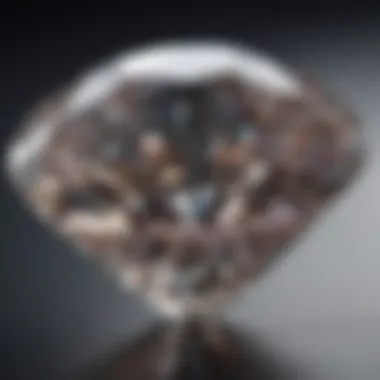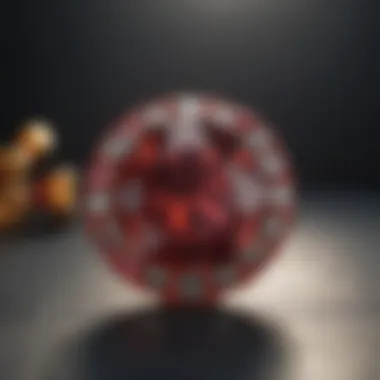Understanding Carats: Value and Significance in Gemstones


Intro
Carats are a central concept in the gemstone market, playing a critical role in determining the value of gems. Understanding what a carat represents and its implications for pricing can enhance one's appreciation for gemstones, whether one is a buyer, collector, or simply an enthusiast. Carat weight impacts pricing, but it is not the only factor to consider; the relationship between carat weight and overall value includes aspects like cut, clarity, and color. This article will examine these elements in detail and provide a broader context for the significance of a carat in the gemstone industry.
Gemstone Overview
Description of the Gemstone
Gemstones are precious or semi-precious stones that have been cut and polished for use in jewelry and ornamentation. They can be natural or synthetic, with natural stones formed through geological processes and synthetic ones manufactured in laboratories. Popular examples include diamonds, rubies, sapphires, and emeralds.
Physical Properties
Physical properties such as hardness, luminosity, and refractive index are crucial in assessing a gemstone's quality. Hardness is measured on the Mohs scale, determining how susceptible a gem is to scratches. Luminosity affects how light interacts with the stone, while the refractive index indicates how light bends within the gemstone. All these factors contribute to the visual appeal and durability that consumers seek.
"The allure of gemstones often comes from a combination of features, not just the carat weight."
Pricing Based on Carat Weight
Factors Affecting Price
Carat weight is a primary determinant of a gemstone's price, but it intertwines with several other factors:
- Cut: The quality of the cut influences how well the gem reflects light. A poorly cut stone can appear dull, regardless of its carat weight.
- Clarity: The presence of inclusions or blemishes will minimize a gem's value. Higher clarity means a clearer appearance, which is held in higher regard.
- Color: For colored gemstones, the hue, tone, and saturation are vital. More vibrant colors in a stone can increase its worth significantly.
Market Trends
Market trends can also pivot pricing significantly. Understanding the supply and demand dynamics helps one navigate investments in gemstones. Seasonal trends often impact when certain stones are more desirable, further adding to their perceived value.
Certifications and Authenticity
Buying gemstones entails knowing the importance of certification. Organizations like the Gemological Institute of America provide grading reports. These certificates ensure that the carat weight and quality characteristics are accurately represented. This verification process is especially vital for high-value stones.
Closure
Prolusion to Carats
The concept of carats holds significant weight in the world of gemstones. Understanding carats is essential for anyone interested in purchasing, collecting, or valuing gemstone jewelry. Carats are not merely a measure of weight; they affect pricing, perceived value, and overall quality. This section will outline the definition and historical background of carat measurement, setting the stage for a deeper exploration of its implications in the gemstone industry.
Definition of a Carat
A carat is a standard unit of weight used for measuring gemstones and pearls. One carat is equal to 200 milligrams. The term "carat" originates from the carob seeds that were historically used as a balance scale to weigh gemstones. The uniformity of the carob seed's weight made it a practical choice, though modern technology no longer relies on it.
The significance of carat weight extends beyond mere measurement. It impacts the value of gemstones directly. For example, a diamond weighing one carat is typically priced higher than a half-carat diamond of the same quality. Jewellers recognize that consumers often perceive larger gemstones as more desirable, which plays a crucial role in pricing strategies.
Historical Background of Carat Measurement
The history of the carat as a measurement unit dates back centuries. Early traders utilized carob seeds for weighing precious stones, particularly in Middle Eastern markets. This practice gradually spread across Europe and Asia. The standardization of the carat measurement occurred in the late 19th century, which aimed to alleviate discrepancies in weight across different regions.
In 1907, the International Bureau of Weights and Measures (BIPM) established the carat as a universal measurement. Since then, the modern carat has been set at 200 milligrams, ensuring consistent and transparent practices in the gemstone market globally.


Understanding these historical roots is vital for comprehending how carats have become an integral part of the gemstone trade. Their evolution reflects changes in commerce, technology, and consumer expectations throughout history.
Carat Weight Explained
Understanding the concept of carat weight is crucial for grasping the overall value of a gemstone. In this section, we will examine the factors related to carat weight, how it impacts price, and its relevance in the gemstone market. Carat weight is one of the four main factors that determine a gemstone's value, alongside cut, clarity, and color. Therefore, familiarity with carat weight can guide purchasers in making informed decisions and investments.
Understanding Weight and Size Relationship
Carat weight is a direct measurement that influences the perceived size of a gemstone. A carat is equivalent to 200 milligrams. This straightforward conversion often misleads buyers who correlate higher carat weight only with larger physical dimensions. While it's true that more carats generally mean more weight, a gemstone's cut profoundly impacts its actual size appearance.
For instance, a well-cut round diamond of one carat may look larger than an equally weighted stone with poor cut. This discrepancy in appearance suggests that an understanding of cut, alongside carat weight, is essential when assessing value and size. High-quality cuts can maximize light return and give a larger appearance, making the evaluation more complex than a mere weight measurement. Hence, when considering gemstone purchases, being aware of this distinction can lead to more satisfying outcomes.
Impact of Carat Weight on Size Perception
The perception of size in gemstones often overwhelms the simple weight figure. Consumers should recognize that visual size does not always correlate linearly with carat weight. For example, two different gemstones can weigh the same yet appear differently due to their shapes
- For instance:
- A one-carat round diamond appears smaller than a one-carat oval diamond.
- A one-carat, well-cut gem often seems larger than a poorly cut equivalent.
The shape and cut quality dictate this perception. Furthermore, buyers should be aware of how settings can influence the appearance of a gemstone’s size. A higher profile setting may create an illusion of a larger stone. Therefore, adjusting expectations around how size is perceived could enhance buyer satisfaction, particularly in the luxury market.
"Understanding the interplay between carat weight, cut, and appearance is critical for anyone considering a gemstone investment."
In summary, while carat weight is significant in determining a gemstone's value, mastery of the relationship between weight and visual size can aid in making knowledgeable decisions. Gemstone enthusiasts must consider all these aspects for a complete understanding of how carat weight translates to meaningful value.
The Pricing of Gemstones
The pricing of gemstones is a pivotal aspect of the gemstone industry. It reflects not only the physical attributes of the stones, but also market dynamics, consumer preferences, and the overall economy. Gemstone pricing is multifaceted, involving a myriad of factors, with carat weight being one of the primary determinants. Understanding these factors can help consumers, collectors, and enthusiasts make informed decisions when buying or investing in gemstones.
How Carat Weight Influences Price
Carat weight directly influences the price of gemstones. Generally, larger stones are more valuable. This correlation can be attributed to both rarity and consumer demand. As the carat weight increases, the cost typically rises disproportionately. For instance, a one-carat diamond may sell for a certain price per carat, whereas a two-carat diamond can command a much higher price per carat due to the increased rarity of larger stones.
Factors that affect pricing based on carat weight include:
- Rarity: Larger gems are less common.
- Desirability: Bigger stones often appeal more to consumers.
- Market Trends: Changing preferences can affect how much individuals are willing to pay.
This means that while carat weight is essential, it is not the sole consideration in pricing. Additional factors like cut and color also contribute to the overall value of the gemstone.
Comparison of Price Per Carat Among Various Gemstones
When comparing price per carat, different gemstones exhibit significant price variations. For example, diamonds tend to have a higher price per carat than sapphires or emeralds. This discrepancy is influenced by factors such as:
- Market Demand: Diamonds maintain steady demand globally.
- Rarity: Some gemstones are far rarer than others, affecting their price.
- Perceived Value: Consumer perception of a gemstone can greatly affect its price.
Understanding these differences is crucial for potential buyers, as it impacts not only the immediate expense but also long-term investment value. Pearls, for instance, can vary greatly in price depending on their size and luster, whereas colored gemstones like rubies or tanzanite may offer better value per carat.
Market Factors Affecting Pricing


Several external market factors play a role in gemstone pricing. These can fluctuate frequently, impacting not just current market prices but also future values. Some key factors include:
- Economic Conditions: Economic downturns can lead to reduced demand for luxury items, such as gemstones, causing prices to drop.
- Import Tariffs: Changes in trade policies can affect international gemstone prices.
- Geopolitical Stability: Regions rich in gemstones may face instability, affecting supply.
- Natural Disasters: Events that disrupt mining operations can lead to scarcity and price increases.
Evaluating Gemstone Quality
Evaluating the quality of a gemstone is crucial for understanding its true value. While carat weight is often at the forefront of consumers’ minds, other factors play a significant role in determining a gemstone’s worth. A holistic view of these variables allows buyers to make informed decisions and appreciate the intrinsic beauty of the gemstones they desire. This section will dissect the three primary elements: cut, clarity, and color, before moving on to the importance of certification in the valuation process.
The Role of Cut, Clarity, and Color
The quality of a gemstone largely hinges on its cut, clarity, and color, often referred to as the "Three Cs." Each of these elements influences not just the aesthetic appeal but also the overall market value.
- Cut: The cut of a gemstone pertains to how well it has been shaped and faceted. A skillfully cut stone reflects light in a manner that enhances its brilliance and fire. Different shapes, like round, princess, or emerald, can affect how the stone captures light.
- Clarity: Clarity refers to the presence of inclusions or blemishes within a stone. A gemstone with fewer imperfections is generally more valued. Clarity is graded on a scale, and stones classified as ‘Flawless’ tend to be among the most sought after, impacting their price significantly.
- Color: Color is perhaps the most visually impactful aspect. For colored gemstones, hue, saturation, and tone are vital. A deep, vivid hue may command a higher price than a lighter tone of the same color. In diamonds, the color grading ranges from D (colorless) to Z (light yellow), with the most precious stones being those that are closest to colorless.
"The interplay of cut, clarity, and color creates a gemstone's overall beauty and value. It's not merely about the stone's weight but how all these elements converge."
Understanding these elements provides a deeper appreciation for gemstones. Buyers should carefully evaluate each characteristic, as they greatly affect the stone's appeal and, ultimately, its price in the market.
Importance of Certification in Valuation
Certification serves as a vital instrument in the valuation of gemstones. It provides authentication and assurance regarding the quality of the stone. Reputable grading institutions like the Gemological Institute of America (GIA) or the American Gem Society (AGS) provide insight into the characteristics of a gemstone, based on rigorous professional analysis. Buyers should consider the following benefits of certification:
- Trustworthiness: A certified stone guarantees that the qualities stated, such as cut, clarity, and color, are from a trustworthy source. This greatly reduces the risk of fraud and misrepresentation.
- Market Value: Certified gemstones typically have a higher market value because they come with a guarantee of quality and authenticity. Their certification also makes them easier to resell.
- Informed Decisions: Certification provides buyers with detailed information about a gemstone. This knowledge allows collectors and enthusiasts to make educated decisions based on facts.
In summary, evaluating gemstone quality is a multifaceted process that goes beyond carat weight. Cut, clarity, and color are fundamental in determining a gemstone’s appeal. Coupled with certification, these factors empower consumers to navigate the market effectively, ensuring they invest wisely in their gemstone purchases.
Consumer Considerations
Understanding carats is essential for consumers involved in the gemstone market. Carats are not just a measure of weight; they play a crucial role in determining value, pricing, and even personal preferences when acquiring gemstones. The awareness of how various factors influence carat value can lead to more informed purchasing decisions, ensuring one gets true value for their investment.
Buying Tips for Different Carat Sizes
When considering a gemstone purchase, the carat size of the stone can greatly impact both visual appeal and cost. Here are some practical tips to guide consumers:
- Know Your Preferences: Decide on the size that appeals to you. Larger stones tend to catch the eye, but higher carat weight may not always fit personal taste.
- Balance Quality with Size: Sometimes, a smaller stone with superior cut, clarity, and color can be more appealing than a larger stone of lower quality. Focus on the overall presentation.
- Consider the Setting: The design of the jewelry can enhance or diminish the appearance of the carat. A well-designed setting may make a smaller stone look larger and more exquisite.
- Budget Appropriately: Larger carat stones significantly increase the price. Set a clear budget to avoid overspending while still seeking quality options.
- Seek Expert Guidance: Consulting with gemologists or reputable dealers can provide valuable insights into market trends and preferences. Their expertise can help you navigate choices effectively.
Common Misconceptions About Carat Weight
Carat weight can often lead to confusion among consumers, resulting in misunderstandings. Here are some prevalent misconceptions:
- Carat Equals Size: While carat weight does influence size, it's not a direct correlation. The cut type can affect how big a stone appears. For example, a well-cut diamond in a lower carat weight can appear larger than a poorly cut larger diamond.
- Higher Carat Always Means Higher Value: Consumers may assume that a larger carat weight always equates to a higher price. However, the overall quality of the stone, including clarity and color, significantly impacts value.
- All Gemstones Have the Same Pricing Rule: Each type of gemstone behaves differently in terms of price per carat. For example, diamonds are generally more expensive than other gemstones for the same carat weight due to their rarity and demand.
Understanding carat weight is crucial for making informed decisions. Consumers should evaluate the overall quality and characteristics of gemstones, rather than focusing solely on carat size.
By recognizing these tips and misconceptions, gemstone enthusiasts can navigate the market with increased confidence, ensuring they make well-informed decisions aligned with both their aesthetic desires and financial considerations.
Gemstone Investment Factors
Understanding the investment factors associated with gemstones is crucial for those interested in collecting or trading these pieces. Investing in gemstones is both an art and a science. It requires knowledge of numerous variables, including market trends, carat weight, and asset longevity. High-value gemstones can potentially offer better returns when they are bought and sold strategically, thus making informed decisions vital.


Carat Weight and Long-term Value
Carat weight significantly influences the long-term value of gemstones. In general, larger stones tend to carry a higher premium compared to those of smaller weights, contributing to their desirability. For instance, while the difference between a one-carat and a two-carat gemstone may not seem substantial in weight, the price difference can be sizeable. This is due to the rarity associated with larger stones.
Additionally, the value of a carat does not simply increase linearly with size. The pricing often escalates due to demand, making larger stones exponentially more valuable. Investors should evaluate potential purchases not just for their current carat weight but also for expected appreciation in value over time.
"The value of gemstones is closely tied to their rarity, which can be highlighted by carat weight alone."
Understanding Market Trends
Market trends play a significant role in gemstone investments. Awareness of fluctuations in popularity can determine whether a gemstone's value will rise or fall. For instance, in recent years, colored gemstones such as sapphires and emeralds have gained traction, influencing their market prices positively. Likewise, diamond prices can shift based on both supply and consumer interest.
Tracking auction results and price indexes can provide insight into where the market is headed. Certain seasons or events, such as holiday seasons or trade shows, can also affect demand. Investors should familiarize themselves with global and local trends to make well-informed decisions about which gemstones to invest in.
Concluding Insights
Key points have emerged throughout the discussion:
- Carat Size and Perceived Value: A gemstone's carat weight significantly impacts its appearance and overall valuation. Potential buyers must consider not just the carat size but also how it relates to other quality factors.
- Market Dynamics: Gemstone pricing is influenced by various market factors, including demand, rarity, and the global economic landscape. Understanding these influences is crucial for making sound buying decisions.
- Certification Importance: The role of certification cannot be overstated. A certified gemstone provides assurance regarding quality and authenticity, which can profoundly affect its long-term value and resale opportunities.
Evaluating these factors collectively leads to a better grasp of the gemstone market and carat values.
Summary of Key Points on Carat Values
The value of a carat intertwines with multiple criteria that dictate the worth of a gemstone. Some of the pivotal aspects include:
- Weight and Size: Larger stones generally demand higher prices; however, the increase isn't linear due to other variables such as quality.
- Quality Factors: As previously mentioned, cut, clarity, and color must also be weighed alongside carat size.
- Market Trends: Awareness of market trends can inform buyers about optimal investment periods, reflecting the shifts in demand for specific gemstones.
Future of Carat Pricing in the Gemstone Market
As we look ahead, the landscape of carat pricing in the gemstone market stands at a crossroads of tradition and technological progress. Various elements will shape future dynamics:
- Emerging Markets: Increasing global wealth is fostering a growing interest in gemstones, particularly in regions like Asia. This shift may elevate demand significantly, impacting pricing structures.
- Sustainable Practices: The rise of ethical sourcing and production may influence consumer preferences, leading to different pricing models based on sustainability.
- Technological Innovations: Advancements in synthetic gemstones and improved methods of gemstone evaluation will potentially alter traditional pricing strategies.
In light of these trends, stakeholders must remain adaptable. Understanding these changing factors can enhance the long-term strategy, whether for investment or personal collection purposes.
"The world of gemstones is changing; stay informed to navigate this evolving landscape effectively."
References and Further Reading
Understanding the nuances of carats and their significance in the gemstone market requires continual exploration and learning. This section provides essential resources to enhance knowledge about carats, gemstones, and related subjects. By leveraging these resources, one can gain deeper insights into the valuation, pricing, and certification processes that govern the gemstone industry.
- Importance of Comprehensive Research
Developing a firm grasp of the carat system involves more than a cursory understanding. Comprehensive resources provide clarity on how various factors affect gemstone valuation. Exploring different materials, from articles to specialized books, caters to a richer learning experience. - Benefits of Varied Perspectives
Gemstones and their valuations are influenced by trends and market dynamics. Engaging with a range of authors and experts helps to cultivate a holistic view of these factors. Books and articles can provide historical context, while online resources might highlight current trends and practices. - Essential Considerations
When selecting resources for further reading, consider their authorship, credibility, and relevance. Look for materials that emphasize research-backed data and insights from established authorities in the field. This ensures that the information is both trustworthy and pertinent to understanding carats and gemstones.
"The pursuit of knowledge is a journey, not a destination. Every source of information contributes to a larger understanding of the subject at hand."
Recommended Books and Articles
Reading specialized books and curated articles offers foundational knowledge as well as advanced insights about carats and gemstones. Here are a few notable recommendations:
- "Gemstones: Properties, Identification and Use" by Keith Wallis
This book provides an in-depth examination of gemstone characteristics, including carat weight, and cannot be overlooked for serious enthusiasts. - "The Gemstone Book: A Guide to the World of Gemstones" by Robert M. Shipley
A valuable resource for beginners and collectors, it covers various gemstones, focusing on valuation and carat measurement. - Articles from National Jeweler
A reputable publication that often covers market trends, carat pricing, and consumer interests.
Online Resources for Gemstone Enthusiasts
The internet offers a wealth of knowledge for gemstone enthusiasts. Some notable platforms include:
- Wikipedia (en.wikipedia.org)
A comprehensive source for basic definitions and historical context surrounding carats. - Britannica (britannica.com)
Offers scholarly articles about specific gemstones and provides quality references for further learning. - Reddit (reddit.com)
The r/gems subreddit is a community where enthusiasts share experiences, advice, and resources pertaining to gemstones. - Facebook Groups
There are multiple groups dedicated to gemstone discussion, sharing insights on carat pricing, and offering advice on purchases.







